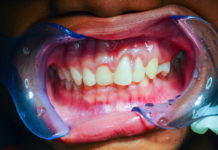 Researchers have discovered bacteria that normally resides on teeth in the synovial fluid of patients requiring joint replacement surgery. The study from the Case Western Reserve University School of Dental Medicine is just one of many that is linking oral bacteria to a host of health problems caused by bacteria that escape from the mouth and enter the blood stream.
Researchers have discovered bacteria that normally resides on teeth in the synovial fluid of patients requiring joint replacement surgery. The study from the Case Western Reserve University School of Dental Medicine is just one of many that is linking oral bacteria to a host of health problems caused by bacteria that escape from the mouth and enter the blood stream.
The researchers, comprising a team of dental, orthopedic and arthritis specialists, points to oral bacteria as a likely cause of “aseptic loosening,” the most common cause of long-term failure in hip and knee replacements. Aseptic loosening occurs when normal wear on a prosthetic joint produces microscopic debris particles that trigger an immune system response that causes artificial joints to fail within 10 years with no identifiable source of infection. The pilot study’s findings were reported in the April issue of the Journal of Clinical Rheumatology.
Dr. Nabil Bissada, chair of the Department of Periodontics at the dental school, said the objective of the study was to see if bacteria, such as Fusobacterium nucleatum and Serratia proteamaculans, commonly found in patients with gum disease, were also present in synovial fluid.
The researchers recruited and studied 36 patients seeking care for osteoarthritis (the wearing of the joints) and rheumatoid arthritis (an autoimmune disease).
The study included participants with both natural and artificial joints who had signs of periodontitis or gum disease. Researcher extracted samples from the synovial fluid that lubricates hip and knee joints for comparison to samples of dental plaque obtained from the patients.
Plaque build-up from bacteria associated with gum disease leads to the destruction of the walls of the gums surrounding the teeth. The inflammation of gums from the bacteria acts like a gateway to allow bacteria to escape the mouth and gain access to the blood stream. Once in the blood, the bacteria can freely travel to remote sites and trigger inflammation that so far has been linked to heart, kidney and cancer diseases and premature births and fetal deaths.
Because these bacteria cannot be found with routine lab tests, detection in the plaque and synovial fluid was done through a process of sophisticated DNA tracking tests.
Five of the 36 patients (14%) showed direct DNA links between the bacteria in their synovial fluid and plaque from the mouth.
Bissada said researchers will continue exploring the oral health link in a larger study. “We have a link now and want to see just how much of a trend this is. We also will be able to see if treating the periodontal disease can reduce the number of future costly joint replacements.”
Source: Témoin, Stéphanie; Chakaki, Alia; Askari, Ali; El-Halaby, Ahmed; Fitzgerald, Steven; Marcus, Randall E.; Han, Yiping W.; Bissada, Nabil F. Identification of Oral Bacterial DNA in Synovial Fluid of Patients With Arthritis With Native and Failed Prosthetic Joints. Journal of Clinical Rheumatology, 18(3):117-121, DOI: 10.1097/
Journal Link: http://1.usa.gov/1uwfDhc
Image: The oral mucosa is the mucous membrane epithelium of the mouth. It is populated with microbes, including many species of bacteria. Some take up residence on the mouth within days after birth. Harmful species form biofilms, like the plaque that encourages tooth decay, or colonize the crevices between teeth and gums, causing periodontal disease. [http://www.micronaut.ch/














[…] pathogens can enter the bloodstream and infect the prosthetic joint (25, 26). Infection of a prosthetic joint can cause total failure and result in serious complications […]
[…] published May 2014 connects periodontal disease and RA. Relatedly: Pg, Pi, and Fn in a study released in 2014 have been found in the synovial fluid of joints, failed joints as well as in the dental […]
I ingested Microbial toxins/microorganisms at a restaurant. Have left knee replacement. My left foot
became paralyzed Aug 1. Foot is getting better. Worried about prosthetic joint infection
[…] on teeth in the synovial fluid of patients requiring joint replacement surgery. A study from the Case Western Reserve University School of Dental Medicine is just one of many that links oral bacteria to a host of health problems caused by bacteria that […]
[…] the body. They have found oral pathogens within the atherosclerotic plaque in the arteries, in the synovial fluid in arthritic joints, brain abscesses, and in the brains of Alzheimer’s disease patients. The bad […]
[…] discovered oral pathogens inside the atherosclerotic plaque within the arteries, within the synovial fluid in arthritic joints, brain abscesses, and within the brains of Alzheimer’s disease sufferers. The […]
[…] cuerpo. Han encontrado patógenos orales dentro del placa aterosclerótica en las arterias, en el líquido sinovial en articulaciones artríticas, abscesos cerebralesy en el cerebro de enfermedad de alzheimer […]
[…] the body. They have found oral pathogens within the atherosclerotic plaque in the arteries, in the synovial fluid in arthritic joints, brain abscesses, and in the brains of Alzheimer’s disease patients. The bad […]